
by Deep Green Resistance News Service | Oct 10, 2018 | Protests & Symbolic Acts
by Max Wilbert / Deep Green Resistance
Last week, I was invited to join a Sacred Water Run-Walk in Nevada by Chief Johnnie Bobb of the Western Shoshone National Council. Chief Bobb attended the Sacred Water, Sacred Forests gathering back in May, and we exchanged contact information.

I decided to attend last minute after his phone call, and gathered my supplies and energies. It is a 14 hour drive from my home in Oregon to the area the walk was to take place, so I took two days to make the drive. I stopped along the way and purchased as much food and supplies as I could afford, although I didn’t know exactly what was needed.

I slept on the night of October 1st in my car at the Swamp Cedars, where we were supposed to meet. The Swamp Cedars are an ecologically unique stand of Rocky Mountain Junipers on the bottom of Spring Valley. Pure water coming out of the ground, shade from the trees, and rich grasses that brought in game animals made this area a gathering place for Newé (Western Shoshone/Goshute) people for thousands of years. It is also why the people were gathered here when they were massacred by the U.S. Calvary, one of several massacres here.
I was awoken before the dawn the next morning when Rupert Steele, the chairman of the Confederated Tribes of the Goshute Reservation, pulled in next to me. We spoke for a while, and then others started to arrive. The others included about 15 or 20 other people from 12 different indigenous nations.
Mr. Steele and Chief Johnnie Bobb both said prayers and burned sage as the sun rose over Spring Valley. I introduced myself to various people, including the woman who organized the run (Beverly Harry). I told her about the food, which she was happy about. Then the runners started out. I stuck around for a while and made some coffee for the elders. One of them asked me to join them in the run-walk, a great honor. I ended up doing 10 miles that day. We did it relay style, so at least one person from the group ran or walked every mile.
We covered 100 miles that first day, then stayed at Cathedral Gorge State Park. We had a nice night around the fire and got to know each other a bit better. I was able to stay through the second day. We covered another 75 miles the second day, and then I had to leave. The runners continued down to the Moapa Paiute reservation.
Our network against the water grab is growing. There were some solid people there. In the event SNWA begins to build the pipeline, there will be serious resistance.

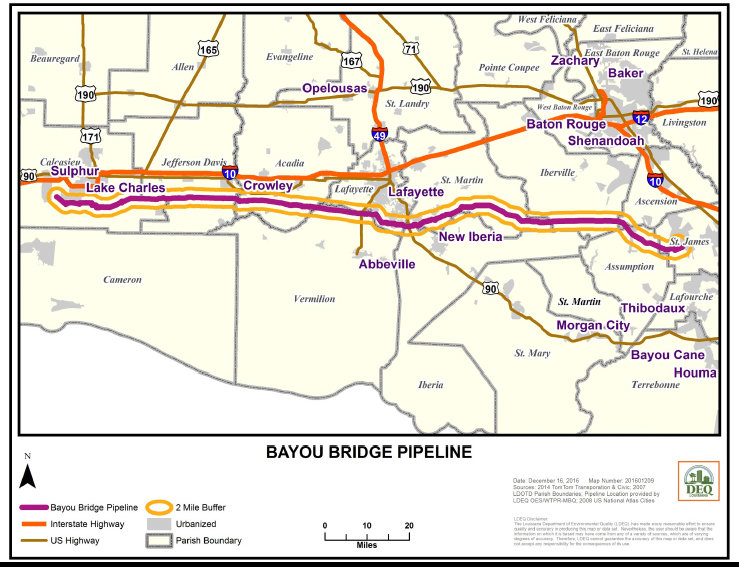
by Deep Green Resistance News Service | Sep 19, 2018 | Protests & Symbolic Acts
In Solidarity with #NoBayouBridgePipeline National Day of Action
by Ginew
BEMIDJI, Minnesota—Early Tuesday morning, September 18th, a group of indigenous water protectors from the Ginew Collective, raised a tipi and blocked a bridge south of Bemidji, halting work at a construction site for the recently permitted line 3 pipeline. Ginew (Golden Eagle) is a grassroots, frontlines effort led by indigenous women to protect Anishinaabe territory from the destruction of Enbridge’s Line 3 tar sands project.
While the tipi blockade prevented bulldozers and street paving machines from laying down new asphalt over the Mississippi, a local Anishinaabe woman held a water ceremony on the bank of the river offering medicine, prayers and songs. The action took place just miles from 3000 year old Dakota village sites near Lake LaSalle where Clearwater county road 230 crosses the headwaters of the Mississippi River.
One member of Ginew declared “We’re here today protecting our water, our burial sites and standing in solidarity with our brothers and sisters down south who are fighting the Bayou Bridge Pipeline. The Mississippi River begins here in the headwaters, where we are standing right now, and it ends in the Gulf of Mexico, in the bayous, where folks have been fighting against Energy Transfer Partners (ETP) for months, putting their bodies on the line for clean water and safer communities. We’re fighting Enbridge here, a different company that is also invested in ETP. Enbridge wants to cross over 200 water ways and drill under the Mississippi River multiple times to construct Line 3. Enbridge wants to put this new poisonous black snake where the river begins and turn this area into an industrial corridor. They want to poison our seed of hope for clean water and turn us into another alley of cancer.”
Many of the work trucks bore out of state plates, one indigenous woman pointed to the out of state plates and explained that “Extractive industry impacts indigenous peoples first and worst – the men come into our communities to build these destructive projects and we women face increased risks of violence, harassment, and potentially life-threatening assaults while our native communities are jurisdictionally limited in the right to prosecute offenders.”
Another water protector put it simply. “We will make it clear that indigenous territories are not sacrifice zones, and the tar sands machine must stop. Line 3 is Enbridge’s single largest project in the company’s history, and with the cancellation of Energy East and uncertain financial backing of Kinder Morgan and Keystone XL, this has become a fight that could cripple the industry while changing the narrative of indigenous peoples within mainstream society. Standing Rock planted seeds across Turtle Island and the world, we Anishinaabe in what is now known as Minnesota are prepared to fight and to stand side by side with indigenous and non-indigenous peoples alike in our work.”
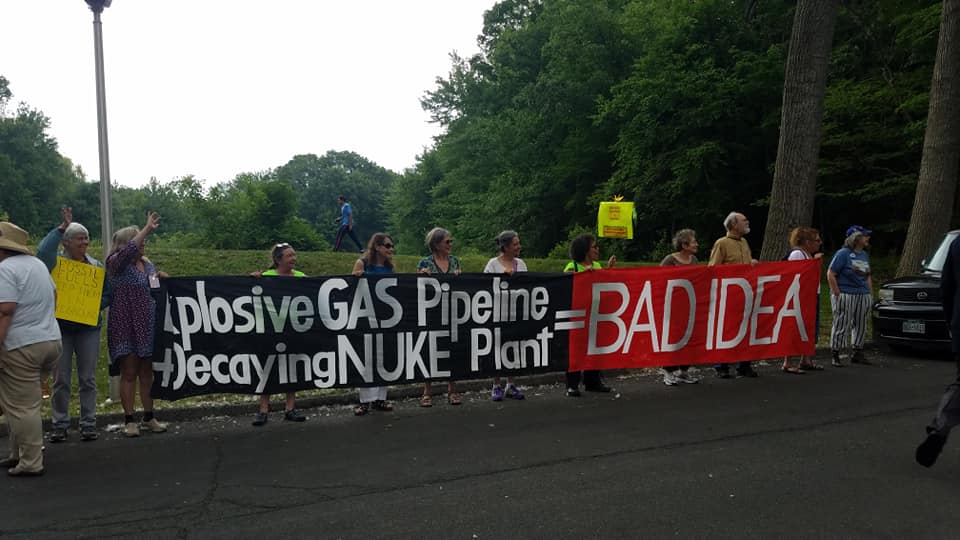
by Deep Green Resistance News Service | Jun 25, 2018 | Protests & Symbolic Acts
Activists’ Fears Confirmed by Newly Released New York State Multi-Agency Report Showing Dangers of Siting AIM Pipeline Next to Indian Point Nuclear Facilities
by ResistAim
Croton-On-Hudson, NY Sunday, June 24, 2018 — Residents of towns near the Algonquin Incremental Market (AIM) pipeline gathered today at a fundraiser where Governor Cuomo was scheduled to appear, to tell the Governor to immediately shut the “Algonquin” Pipeline down. Today’s protest is a response to the New York State multi-agency Risk Assessment regarding co-locating a high pressure, high volume fracked gas pipeline alongside the failing Indian Point Nuclear Power Plant; the report was due over a year and a half ago and its executive summary was released on Friday evening. This report substantiates arguments made for years by community members, experts, and elected officials that the Federal Energy Regulatory Commission (FERC) did not sufficiently consider risks and other concerns before constructing the “Algonquin” Incremental Market (AIM) Pipeline expansion alongside Indian Point.
In February 2016, the Governor ordered the New York State Department of Homeland Security and Emergency Services (DHSES), Department of Public Service (DPS), Department of Health (DOH), and the Department of Environmental Conservation (DEC) to undertake the Risk Assessment. Last year, construction was completed on the AIM Project, a high-pressure, 42’ inch diameter, fracked gas pipeline that runs under the Hudson River and within 110 feet of critical safety infrastructure for the aging and failing nuclear plant. The pipeline was completed after years of protest from the community and beyond, and in direct opposition to objections from elected officials at all levels. Further, this pipeline was built despite a report from the Massachusetts Attorney General showing that the additional capacity was not needed for the region to meet its energy needs.
While Governor Cuomo was a no-show at the event, activists did speak with Lieutenant Governor Kathy Hochul, demanding the state act immediately now that it has evidence of the risks posed by the pipeline. Despite attending the fundraiser only a few miles from the plant, the Lieutenant Governor said she wasn’t well versed on the topic and couldn’t speak to the state’s next steps. “How can the Lieutenant Governor attend an event only a stone’s throw from the plant and not be aware of the risk assessment that was released only 48 hours ago saying the home she was standing in was in danger?” asked Courtney Williams, a Peekskill resident who attended the rally with her young daughter. “We’ve been pressing the state on this for years. The fact that she was unable to speak to us about this is just more evidence that New York State isn’t doing its due diligence to protect us.”
“For years we have been saying that none of the Federal agencies were evaluating all the necessary risks when they granted permits for this pipeline. The Risk Assessment executive summary released on Friday is clear evidence that an independent contractor and four State agencies agree that there are too many unanswered questions to accurately assess the risk of running a high pressure, fracked gas pipeline right by Indian Point. The Governor must stop the the flow of gas at least as long as so many questions remain unanswered,” said Amy Rosmarin, co-founder of Stop the Algonquin Pipeline Expansion (SAPE).
“This Risk Assessment could have been completed and released before the AIM Pipeline construction was finished,” said Tina Volz-Bongar, from Resist Spectra. “Now we are in a situation where gas is flowing through a pipeline for which proper safety determinations were not made. We are calling on the Governor to go to FERC and ask for an immediate stay to halt the gas flow alongside and under Indian Point,” she continued.
“Given what the Risk Assessment says, it is incumbent upon the Governor to direct the Public Service Commission to use its authority under PHMSA (Pipeline Hazardous Materials and Safety Administration) to turn off the AIM Pipeline and do a proper safety and risk assessment without residents living daily with the potential danger of fracked gas under the plant,” said Nancy Vann, co-founder of Safe Energy Rights Group (SEnRG).
Today, community members and groups called on the Governor to shut the pipeline down by directing the Public Service Commission to exercise its authority over pipelines under PHMSA (Pipeline Hazardous Materials and Safety Administration).
“While the probability of pipeline incidents is low, the proximity to the Indian Point nuclear plant makes the potential consequences of such an event very significant,” said the agencies in their press release. “Additional scrutiny and monitoring to better understand and reduce risks associated with the Algonquin pipelines is warranted. FERC must engage in further action to mitigate and investigate potential risks.”
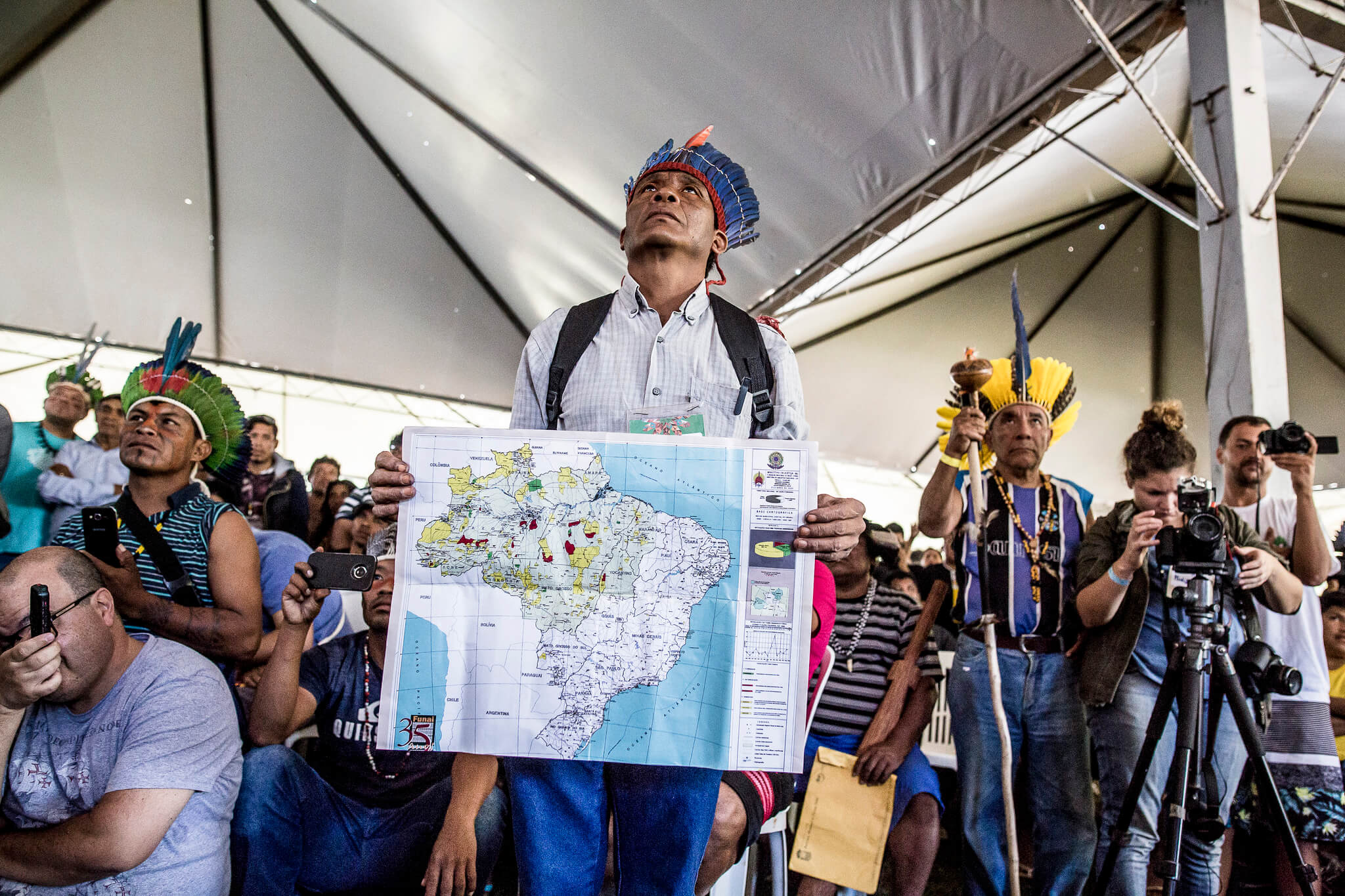
by Deep Green Resistance News Service | Jun 14, 2018 | Protests & Symbolic Acts
Featured image: Photo: Mídia NINJA/flickr (Some Rights Reserved). Political setbacks in Brazil give renewed thrust to annual mobilization for land rights.
The camp smelled like smoke and urucum, a plant used for body painting. A defiant energy pulsed through the crowd. We could hear chants, ritual mantras, and ceremonial crying.
The place resounded with the voices of the more than 3,000 indigenous people from more than 100 different groups from all over Brazil, who gathered for the five-day 2018 National Indigenous Mobilization, held from April 23 to 27 in Brasilia, the Brazilian capital city.
Also known as the ‘Free Land Camp’ (‘Acampamento Terra Livre’, in Portuguese), the sit-in is a yearly event organized by the Articulation of the Indigenous Peoples of Brazil (APIB, in the Portuguese acronym). This year’s was its 15th edition.
According to the last Brazilian demographic census, there are 305 indigenous populations in Brazil, speaking 274 different languages. Together, they number almost 897,000 — approximately 0.47% of the country’s 200-million-strong population.
Most of them are scattered over thousands of villages, from north to south of the national territory, located in the 715 Indigenous Lands already regularized and formally recognized by the federal government. There are more than 800 cases of indigenous lands awaiting regularization.
The ‘Genocide Opinion’ and other blows
The movement has been facing a series of political setbacks, which gave renewed thrust to this year’s mobilization.
The Brazilian National Congress, whose majority is currently dominated by supporters of the agribusiness sector, are trying to approve a bill package that would undermine the rights of indigenous peoples guaranteed by Brazil’s 1988 Constitution and other international laws, such as Convention 169 of the International Labor Organization.
In the current complex political situation in Brazil, under the controversial administration of president Michel Temer, representatives of the agribusiness sector have gained even greater footholdand managed to also occupy other levels of government.
Only days before the Free Land Camp took place, President Temer yielded to pressure from a ruralist caucus and fired the president of the National Indigenous Foundation (FUNAI), replacing him with someone more agro-friendly.
The government’s reluctance to grant formal recognition of indigenous lands’ boundaries and the criminalization of the movement’s leaders were major points of concern and grievance for those who gathered in Brasilia.
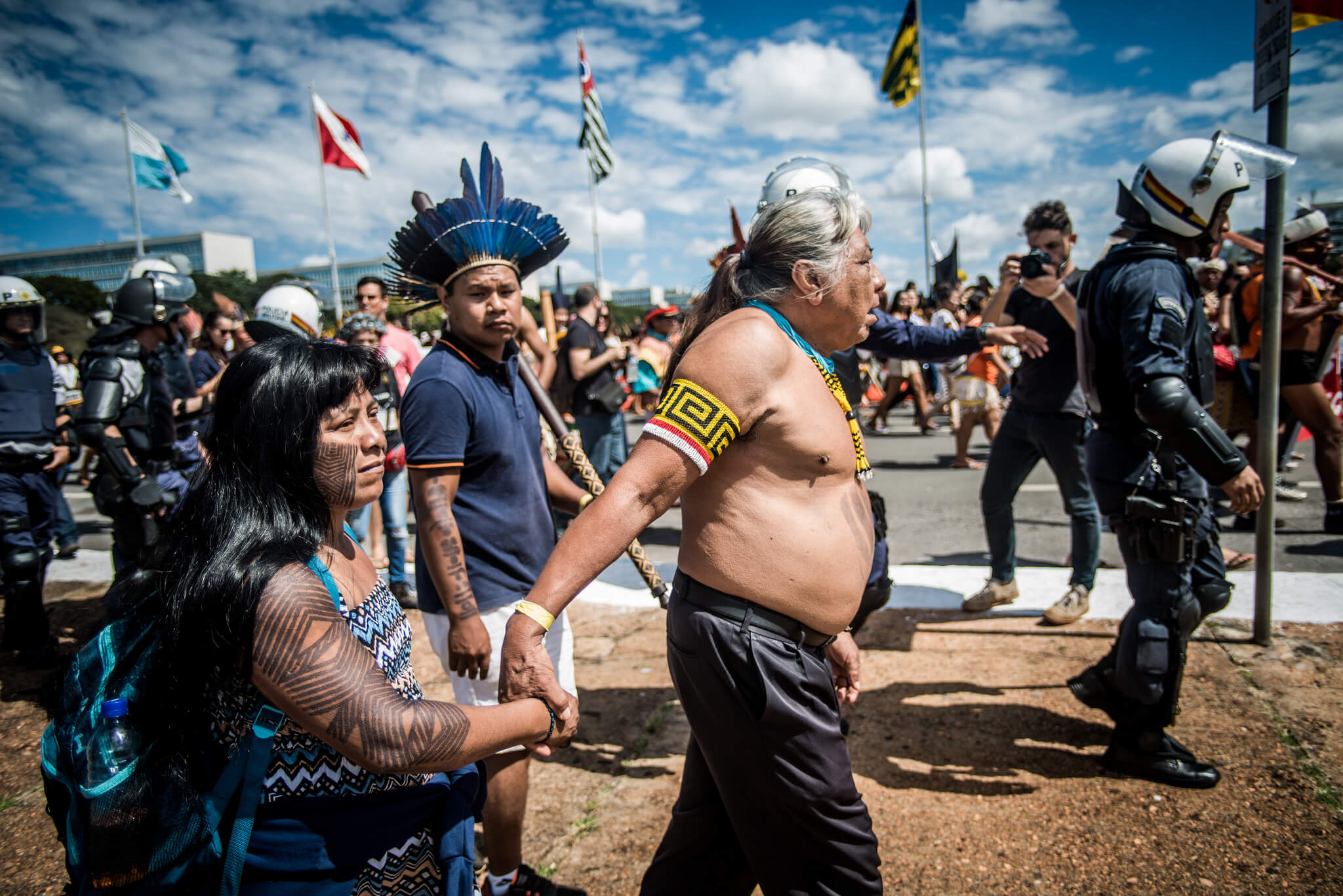
Photo: Mídia NINJA/flickr (Some Rights Reserved)
Kretã Kaingang, an indigenous leader from the state of Paraná and coordinator of the indigenous program of 350.org in Brazil, recalled the kind of threats he has faced. “I was imprisoned for a time, accused of crimes that were not proven and I have been prevented by a judge from approaching the land where I was born. For four years I couldn’t step on the place where my umbilical cord is buried,” he said.
In September 2017, Brazil’s attorney general issued a legal opinion asserting that only indigenous peoples who were occupying their territory on the day the 1988 Constitution was promulgated should benefit from the recognition of their right to land.
Known as the “time limit” thesis, and sometimes called the “genocide opinion“, it has been endorsed by President Michel Temer. Should it ever become law, it would severely cripple the recognition of new indigenous lands.
The night fell as the indigenous leaders stood in vigil in front of the federal government building. At one point, the crowd raised candles and stopped their activities to listen to a lament sung by one of the indigenous women. It was a mourning ceremony.
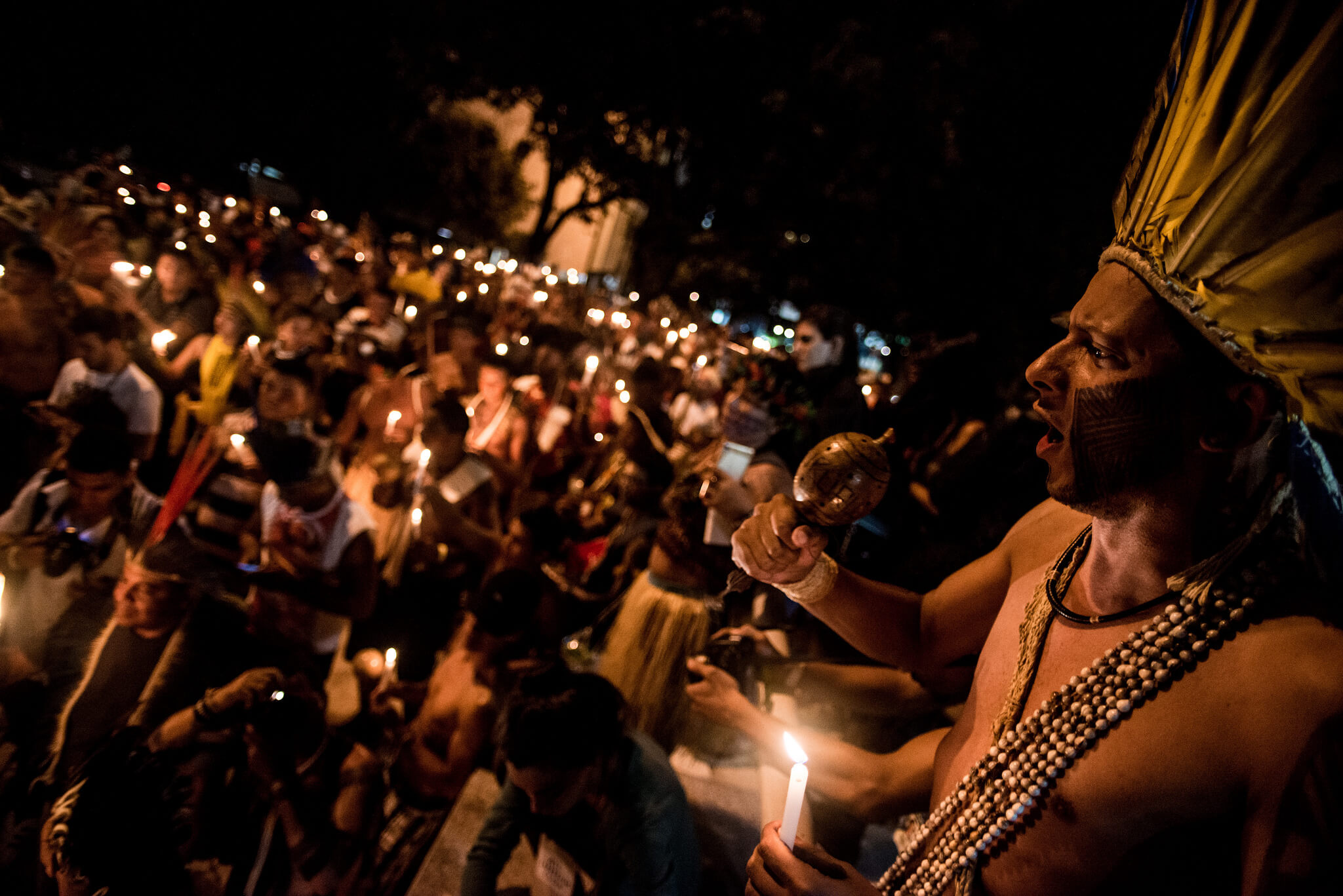
Photo: Mídia NINJA/flickr (Some Rights Reserved)
On the following day, the Esplanade of Ministries, the main route where all federal government buildings are located, was occupied again by protesters, who marched towards the seat of the National Congress.
With paintings and adornments, dancing and singing war cries, indigenous Kaingang, Guarani, Guarani-Kaiowá, Guarani-Mbya, Xucuru, Pataxó, Munduruku, Awá-Guajá, Guajajara, Marubo, Xerente, Xavante, Kayapó, Tenetehara, Tembé, Tucano, Krahô, Kanela and many others demanded the process of demarcation of their lands be resumed and asked for respect for their rights, as enshrined in the 1988 Constitution.
Indigenous leaders carried banners with messages targeted at the authorities: “Demarcation Now!”, “No fracking in our lands!” and “Guarani resists”. Other signs called out the destruction of territories, rivers and natural resources by giant infrastructure and energy projects.
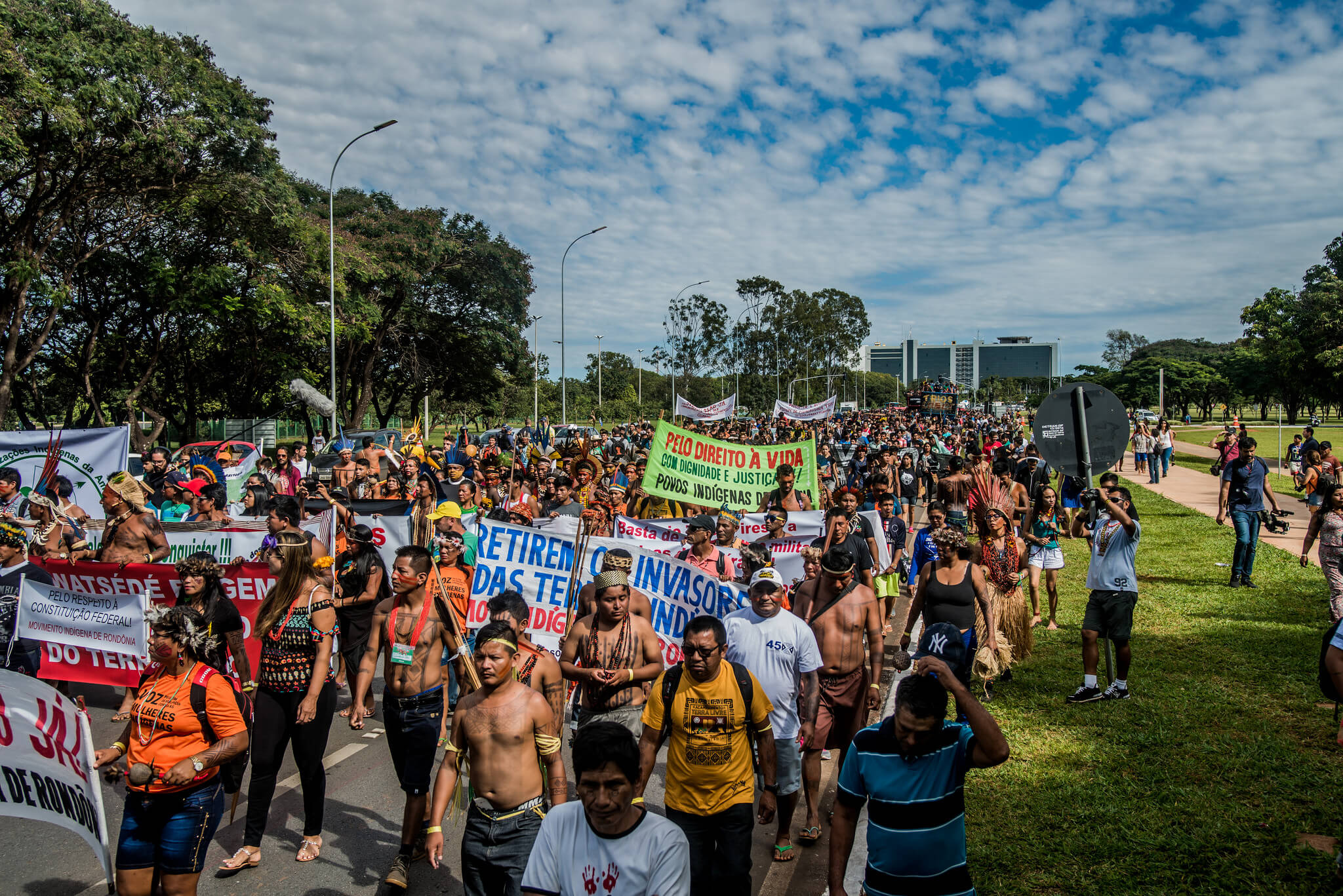
Photo: Mídia NINJA/flickr (Some Rights Reserved)
“We have only one objective here: to resume the process of demarcation of our lands. Many of our relatives could not join us, so we came to represent our communities,” said Kretã Kaingang.
During the demonstration, the street was stained red, symbolizing the blood shed by indigenous people during acts of repression and violence which are considered by many a continuation of the historical genocide perpetrated against them during colonial times.
“‘The trail of ‘blood’ we leave represents the violence and attacks imposed by the state to the original peoples of this country. Several invasions, threats, and assassinations have been occurring in Brazil, in addition to a cruel process of criminalization of our leaders. But despite this problematic conjuncture, we will always resist and fight, as we learned from our ancestral warriors,” said Chief Marcos Xukuru of Pernambuco.
Joênia Wapichana, the first indigenous woman and indigenous lawyer to stand up in the Federal Supreme Court, recalled what is really at play: “The fact that the Executive Branch has an instrument to restrict the right to demarcation puts the lives of all indigenous peoples at risk, whose subsistence depends directly on the land and everything it gives.”
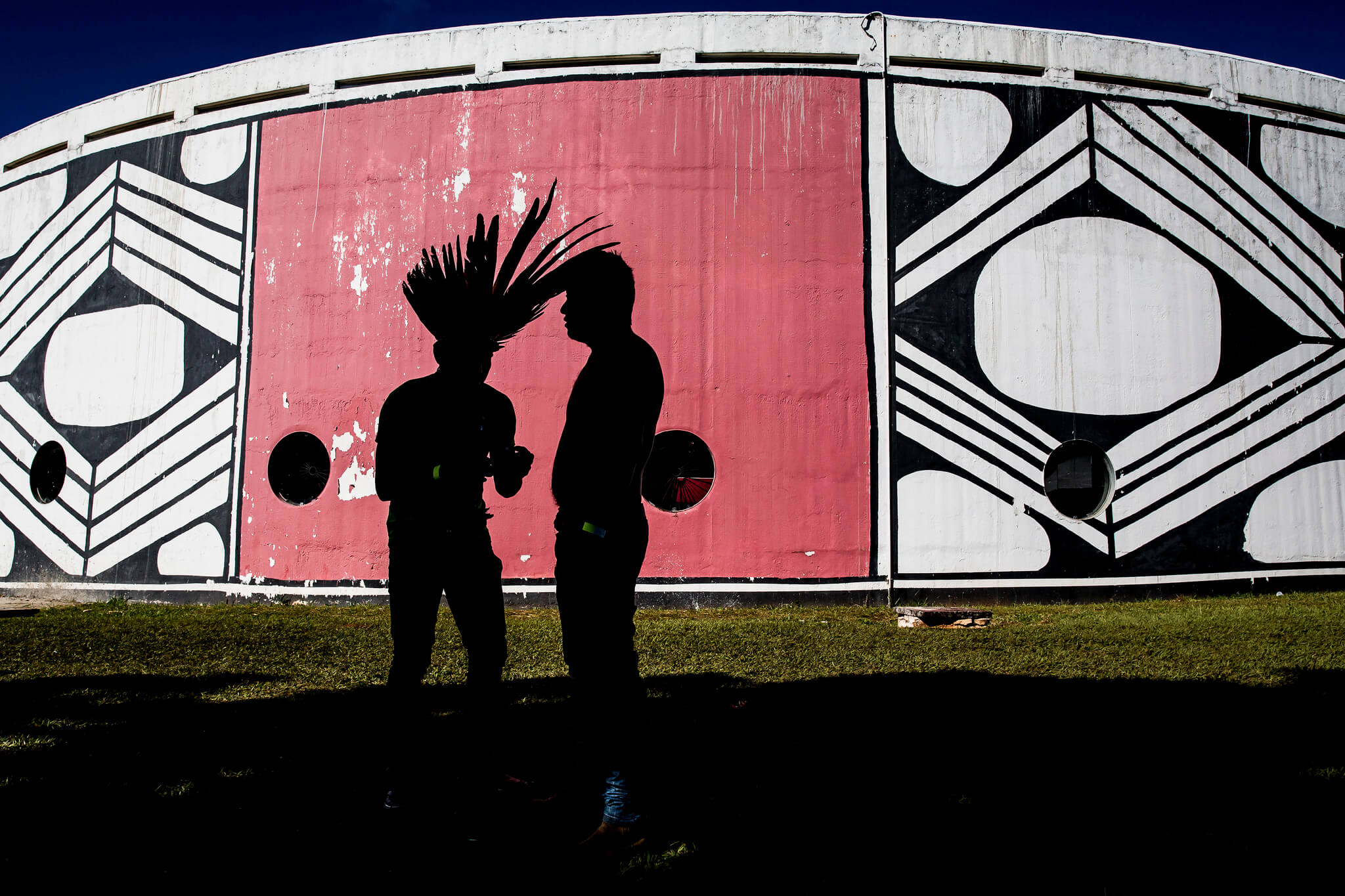
Photo: Mídia NINJA/flickr (Some Rights Reserved)
“The demarcation of our lands equals their preservation. We have heard reports from our relatives from all regions about invasions pursued by loggers, prospectors, grabbers and state enterprises. What we want is to ensure the lives of future generations. We fight here not only for us indigenous peoples but for the Brazilian society as a whole,” said Tupã Guarani Mbya, from the Indigenous Land Tenondé Porã, in São Paulo.
For the chief Juarez Munduruku, indigenous peoples are like trees. “There’s life in the trees just as there is in us. If you kill them, they die and never come back. If a logger kills a ‘cacique’, a story ends.”
He recalled that in the middle of the Tapajós River, in the Amazon, where his territory is located, there are plans to build 43 big hydroelectric plants, which will dam one of the largest rivers in the country, a sacred place for his people. Two of these projects have already been implemented, and there are plans to also build 30 ports to transfer monoculture soybeans, in addition to mining and illegal logging.
by Deep Green Resistance News Service | Apr 30, 2018 | Protests & Symbolic Acts
by Survival International
Thousands of indigenous people gathered in Brazil’s capital this week, to protest against plans to destroy their lands and lives.
The Indians, from tribes across the country, painted the streets with “blood,” marched through the city, demonstrated at government buildings, and called for their rights to be respected.
Sonia Guajajara, an indigenous leader and candidate for the Vice-Presidency in Brazil’s upcoming general election, said: “We are denouncing the genocide of our people…This is the most suffering we’ve experienced since the dictatorship. By staining the streets red, we are showing how much blood has been shed in our fight for the protection of indigenous lands… The fight goes on!”
The protest marks Brazil’s “Indigenous April” and follows the annual “Day of the Indian,” 19 April, when the country’s President often announces some progress in the protection of indigenous peoples’ ancestral lands. This year, no such announcements were made. Instead, it was reported that the head of the government’s Indigenous Affairs Department would be replaced, as he was not fulfilling the demands of anti-indigenous politicians and ranchers.
Politicians linked to the powerful agribusiness lobby are pushing through a series of laws and proposals which would make it easier for outsiders to steal indigenous peoples’ lands and exploit their resources.
This would be disastrous for tribes across the country, including the Guarani, who suffer one of the highest suicide rates in the world, as most of their land has been stolen for cattle ranching and soya, corn and sugarcane plantations.
Adalto Guarani told Survival International of the politicians’ plan: “Please help us destroy this! It’s like a bomb waiting to explode, and if it explodes, it will put an end to our very existence. Please give us a chance to survive.”
And uncontacted tribes, the most vulnerable peoples on the planet, could be wiped out if their lands are opened up. Tribes like the uncontacted Kawahiva and Awá are on the brink of extinction as they live on the run, fleeing violence from outsiders. But if their land is protected, they can thrive.
Survival International and its supporters in over 100 countries are working in partnership with tribes across Brazil to prevent their annihilation and the extinction of their uncontacted relatives.

by Deep Green Resistance News Service | Apr 28, 2018 | Protests & Symbolic Acts
Featured image: Destruction in León. Source anonymous. The official death toll from explosions of state violence has risen to 63.
by Laura Blume / Intercontinental Cry
Over the past week, Nicaragua has erupted in protests. While this current crisis started over pension reform, its development has revealed far greater rifts. It appears Nicaraguans have finally had enough of the Ortega regime. They are demanding that the corruption and oppression end. For many, it may seem shocking that a country that re-elected President Daniel Ortega for his third consecutive term in November 2016, with a reported 72 percent of the national vote could now, less than two years later, have taken to the streets en masse demanding his immediate removal from office.
I first visited Nicaragua in 2012, and have spent extensive time in the country over the past two years undertaking ethnographic fieldwork as part of my PhD dissertation. Each time I arrived in Nicaragua, I heard more and more people express mounting levels of frustration with the political situation. Yet, it was a frustration that the majority internalized and kept mainly to themselves, mentioning it to me only in private spaces and usually when other Nicaraguans were not around. As someone explained to me on one of my first trips to the country, “On the street, we’re all Sandinistas. We have to be if we want to work and have our kids go to school. But in private… well, there you may hear another story.”
I began hearing people who had fought in the 1978-79 Sandinista Revolution and 1981-90 Contra War lament that the current government now resembled the Somoza dynasty they had fought so hard and sacrificed so much to overthrow. Many people told me they were still a Sandinista, just not a Danielista, highlighting their commitment to the ideals of the historic fight against dictatorship and the Sandinista Revolution, but fundamental disagreement with the current regime.
Hearing about corruption and repression is one thing, but witnessing it is another. In November 2017, in Bilwi, the capital city of the North Caribbean Coast Autonomous Region of Nicaragua, I watched the Ortega Administration steal a local election. As I felt the burn of tear gas deployed against peaceful protestors and watched National Police – trucked in from the capitol – fire live rounds at the crowds, perspective on Nicaraguan politics changed, permanently.
In the 2017 municipal elections in Bilwi, the primary match-up was between two parties: the FSLN (Frente Sandinista de Liberacion Nacional, Sandinista National Liberation Front) and the indigenous Miskitu party YATAMA (Yatama Aslatakanka Masrika Nani/Sons of the Mother Earth). I decided I would try and divide my time between the contacts I had from each party, hoping to remain impartial. On election day, I spent the morning with a contact who supported the FSLN. I accompanied them as they drove FSLN voters to the polls. At one point, they admitted to me that certain claims of the opposition were valid: Nicaragua was a dictatorship. But they countered that not all dictatorships were bad, exclaiming, “just look at all the progress in Cuba!”
Around 4 pm that afternoon, I arrived at a voting center with a YATAMA contact. Although the official closing time for the center was 6pm, elections officials were shutting its doors. People became angry that they were not being allowed to vote. The situation grew tense as a crowd formed. People reported facing harassment from authorities – including two women who told me about threats of sexual violence – when they tried to demand their right to vote. I remember thinking how my FSLN contacts had stressed to me that they would be voting early in the day, and making sure other FSLN supporters did the same. Did they know this would occur in the afternoon? Reports of similar problems soon emerged from other voting centers around Bilwi.
A few hours later, waiting outside the same voting center in a crowd of YATAMA supporters as they observed a contested re-count of votes, I noticed a new group of people arriving – all young and male. They began encircling the YATAMA supporters and jeering at them. One of the young men tossed a handful of dirt towards them, clearly trying to instigate a fight. Thankfully, the YATAMA supporters did not take the bait. But in that moment, I got a glimpse of the nature of the Sandinista turbas, the same groups of youths who are now terrorizing various parts of the Pacific coast and the capital city of Managua.
Once the FSLN victory was announced, YATAMA supporters took to the streets to protest what they perceived as a fraudulent outcome. While I had tried to remain politically neutral, I certainly empathized with their frustration. The irregularities at the voting centers seemed far too widespread to consider the FSLN win a fair one. Moreover, those who did vote for the FSLN often did so because they felt obliged to do so. As one young woman told me, she had wanted to support YATAMA, but voted for the FSLN since she was fearful of losing her university scholarship.
FSLN-controlled media outlets declared that the YATAMA supporters were causing mayhem in the city, but they were certainly not alone on the streets. Groups of the FSLN youth were out in force, fighting against the YATAMA supporters and vandalizing properties. The YATAMA house and radio station (which serves as one of the few Miskitu-language services in the region) and famous defiant Indian statue were all destroyed, which some audacious Sandinista sources blamed on YATAMA supporters. Through all of this, the protesters faced violent government suppression, including tear gas and even gunfire. Adding to the disarray, groups of criminals who claimed no political loyalties took advantage of the chaos to loot local businesses. One jokingly asked me if I wanted any new electro-domestic appliances from Gallo Más Gallo.

Injured protesters taking refuge in the YATAMA house, before it was burned to the ground. Photo by author.
After a day and a half of the protests, the local airport was shut down and rumors circulated that troops would soon blockade the road. I decided it was time for me to leave town.
Unbeknownst to me, a fight at the bus station broke out 15 minutes prior to my departure time. When I arrived, it was full of police and special forces from Managua, antimotines. As I approached the bus, eager to leave, an official stopped me. He claimed that he had seen me the day before at the protests and ordered that nearby police search my luggage as he closely examined my passport. He demanded my name, which he wrote down. Without my permission, he took a photo of my face with his phone to send to “central.” He also insisted that I hand over my cellphone and delete any protest photos.
The official also accused me of supporting YATAMA and of even working for the CIA – a potentially grave accusation in a country still reeling from the U.S. infringements of the 1980s. I insisted I was a poor graduate student incapable of backing any foreign political party and that I did not work for any government agency. (I was tempted to point out that a CIA agent would have nicer transportation than the local 18-hour “chicken” bus from Bilwi to Managua I was taking, but decided that snark would not help in this situation.) Finally, the official let me go and I boarded the bus. I have never been so relieved to take a seat and settle in for the grueling ride to the capital as I was at the moment the bus finally puttered out of the tiny Bilwi bus depot.
Upon arrival on the Pacific side of the country, a few of my friends joked that I needed to go buy some pro-FSLN swag to help improve my image in the eyes of the government. The Pacific side of Nicaragua was mostly calm after the municipal elections, and most of the people I spoke with dismissed the chaos in Bilwi as something unique to the dynamics on the indigenous-dominated and long-fractious Miskitu Coast. Yet, no Nicaraguan I spoke with was surprised by my tale of police harassment and voter suppression. The most common response to my depiction of the ways the FSLN had strategically manipulated the election outcome was laughter; this was all very old news to Nicaraguans.
Now, in April 2018, the protests are not specific to an election, led by an opposition party, or isolated in a remote part of the country. The protests are occurring all across the heartland of supposed FSLN support. The below photo is from Friday night in León, where the FSLN won the 2017 municipal elections with over 80 percent of the vote. While the government says right wing-backed criminals are responsible for the vandalism, witnesses say it was the Sandinista turbas who were, quite literally in this case, pouring gasoline on the fire.
Some Nicaraguans tell me that the situation has started to calm down. Others say it is just the calm before the storm. Regardless, even if things settle down this time, the mask of democracy has been torn off the Ortega regime. So far, during less than a week of protests, at least 63 people have been killed*, and many more are injured or missing. Nicaraguans are now publicly speaking out against their repressive government, and hundreds of thousands are taking to the streets. Yet, dictators rarely cede power in response to protest, and so this struggle is unlikely to be a fast or an easy one.
I initially wanted to write about what I witnessed in Bilwi, but I decided to stay silent, for the same reason that Nicaraguans do not like to talk about politics on the street: speaking out against the Ortega regime almost always has consequences in Nicaragua. This government has expelled several researchers and academics before me, threatening them along the way. But, now, like so many of my friends in Nicaragua and on their behalf, I am enraged by what is happening. It is hard to silently watch the videos of a journalist being shot in the head in a city that I have come to consider a second home, or of students and protestors being beaten, abducted, and even killed by government forces along streets I have walked too many times to count. As a friend in Managua recently told me, “it is difficult to feel so impotent, but you know what is beautiful? To be next to someone who you do not know but you help and you defend because they believe in the same thing you do.” I cannot be on the streets of Managua marching with the protestors right now, but I can provide a voice that amplifies the calls of those protesters – and as an academic, further evidence that supports their cause.













